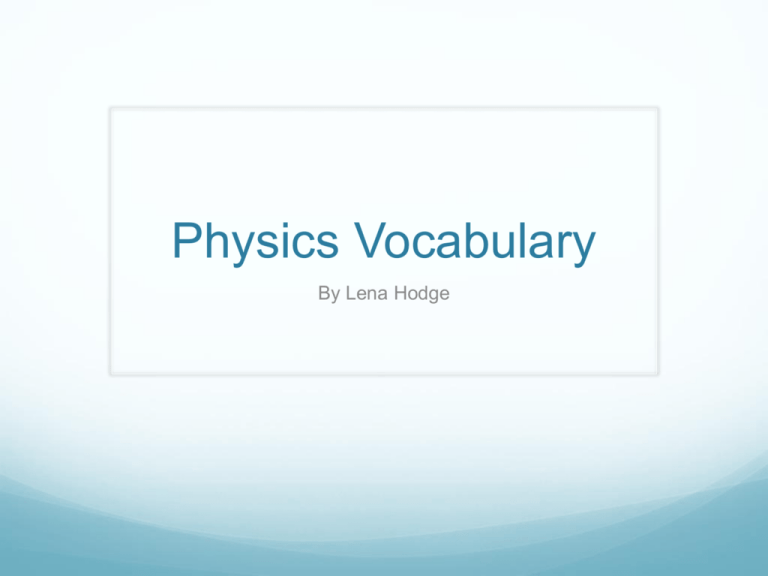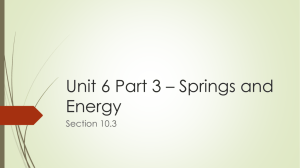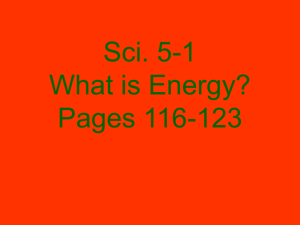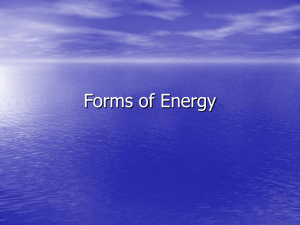Vocabulary - Lena - Purvis' Science Spot
advertisement

Physics Vocabulary By Lena Hodge Introduction Chapters 1-7 Vocabulary and their meanings. All vocabulary for chapters Models, System, hypothesis, controlled experiment, accuracy, precision, significant figures Frame of reference, displacement, average velocity, instantaneous velocity, acceleration, free fall Scalar, vector, resultant, components of a vector, projectile motion Force, inertia, net force, equilibrium, weight, normal force, static friction, kinetic friction, coefficient of friction Continued…. Work, kinetic energy, work-kinetic energy theorem, potential energy, gravitational potential energy, elastic potential energy, spring constant, mechanical energy, power Momentum, impulse, perfectly inelastic collision, elastic collision Centripetal acceleration, gravitational force, torque, lever arm Chapter 1 Model- a pattern, plan, representation, or description designed to show the structure or workings of an object, system, or concept. System- a set of particles or interacting components considered to be a distinct physical entity for the purpose of study. Hypothesis-an explanation that is based on prior scientific research or observations one that can be tested Chapter 1 continued.. Controlled experiment- an experiment that tests only one factor at a time by comparing a control group with an experimental group. Accuracy- a description of how close a measurement is to the correct or accepted value of the quantity measured. Precision- the degree of exactness of a measurement Chapter 1 continued.. Significant figures- those digits in a measurement that are known with certainty plus the first digit that is uncertain Chapter 2 Frame of reference- a system for specifying the precise location of objects in space and time Displacement- the change in position of an object Average velocity- the total displacement divided by the time interval during which the displacement occurred Instantaneous velocity- the velocity of an object at some instant or at a specific point in the object’s path Chapter 2 Continued.. Acceleration- the rate at which velocity changes over time; an object accelerates if its speed, its direction, or both change. Free fall- the motion of a body when only the force due to gravity is acting on the body Chapter 3 Scalar- a physical quantity that has magnitude but no direction Vector- a physical quantity that has both magnitude and direction Resultant- a vector that represents the sum of two or more vectors Components of a vector- the projections of a vector along the axes of a coordinate system Chapter 3 Continue.. Projectile motion- the motion that an object exhibits when thrown, launched, or otherwise projected near the surface of Earth Chapter 4 Force- an action exerted on an object that may change the object’s state of rest or motion Inertia- the tendency of an object to resist being moved or, if the object is moving, to resist a change in speed or direction Net force- a single force whose external effects on a rigid body are the same as the effects of several actual forces acting on the body Equilibrium- the state in which the net force on an object is zero Chapter 4 continued.. Weight- a measure of the gravitational force exerted on an object; its value can change with the location of the object in the universe Normal force- a force that acts on an object lying on a surface, acting in a direction perpendicular to the surface Static friction- the force that resists the initiation of sliding motion between two surfaces that are in contact and at rest Chapter 4 continued.. Kinetic friction- the force that opposes the movement of two surfaces that are in contact and are sliding over each other Coefficient of friction- the ratio of the magnitude of the force of friction between two objects in contact to the magnitude of the normal force with which the objects press against each other Chapter 5 Work- the product of the component of a force along the direction of displacement and the magnitude of the displacement Kinetic energy- the energy of an object that is associated with the object’s motion Work–kinetic energy theorem- the net work done by all the forces acting on an object is equal to the change in the object’s kinetic energy Chapter 5 continued.. Potential energy- the energy associated with an object because of its interaction with the environment Gravitational potential energy- the potential energy associated with an object’s position relative to a gravitational source Elastic potential energy- the energy stored in any deformed elastic object, such as a compressed spring or stretched rubber band Chapter 5 continued.. Spring constant- a parameter that is a measure of a spring’s resistance to being compressed or stretched Mechanical energy- the sum of kinetic energy and all forms of potential energy Power- a quantity that measures the rate at which work is done or the rate of energy transfer by any method Chapter 6 Momentum- a vector quantity defined as the product of the mass and velocity of an object Impulse- the product of the force and the time interval over which the force acts on an object Perfectly inelastic collision- a collision in which two objects stick together after colliding Elastic collision-a collision in which the total momentum and the total kinetic energy are conserved Chapter 7 Centripetal acceleration- the acceleration directed toward the center of a circular path Gravitational force- the mutual force of attraction between particles of matter Torque- a quantity that measures the ability of a force to rotate an object around some axis Lever arm- the perpendicular distance from the axis of rotation to a line drawn along the direction of the force Conclusion To sum it all up you have just learned all the vocabulary you will need to know for chapters 17.










